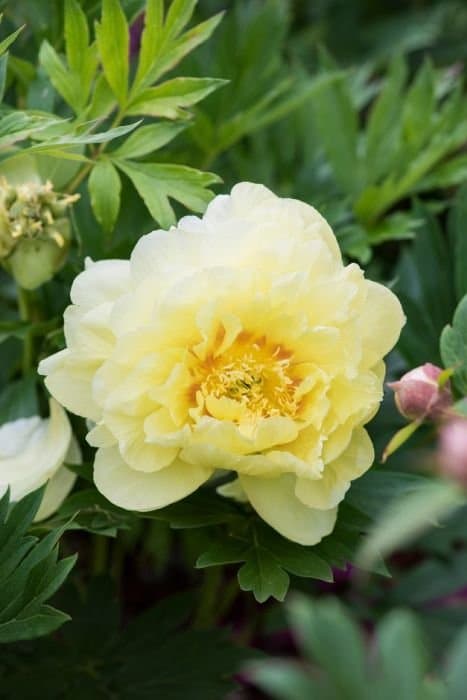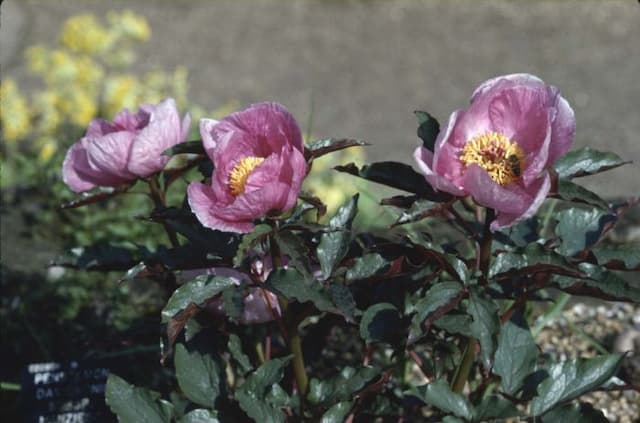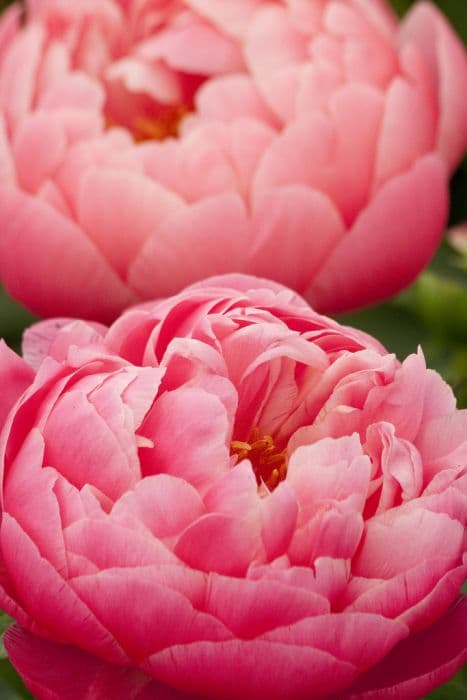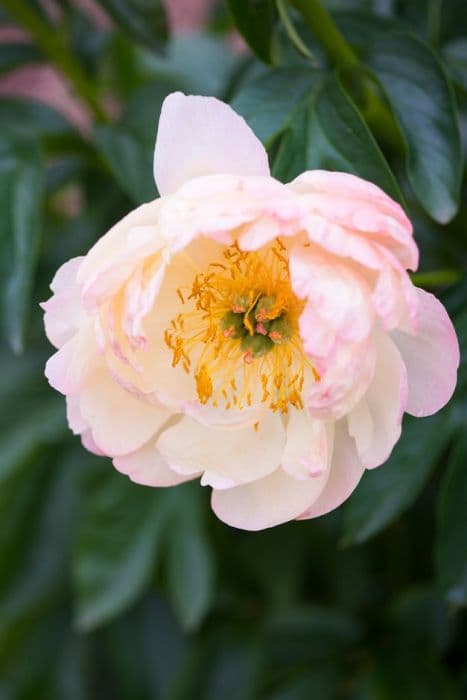Tree Peony Paeonia × suffruticosa 'Yachiyo-tsubaki' (S)

ABOUT
The 'Yachiyo-tsubaki' is a type of tree peony with a stunning and elegant appearance. This plant is known for its large, exquisite blooms which are among the most showy and ornamental flowers in the plant world. The flowers are often multi-petaled, giving them a lush, full look, and they come in a palette of colors, including varying shades of pink and may have blushes of cream or purple. The petals are soft and delicate, sometimes possessing a silky sheen, with a texture that can be reminiscent of fine tissue paper. At the center of each bloom, a cluster of contrasting yellow stamens adds a striking pop of color, which enhances the flower's beauty and provides a stark contrast against the softness of the petals. The leaves of the 'Yachiyo-tsubaki' are deep green, offering a rich backdrop that makes the floral colors stand out even more. The foliage might, on some specimens, have a leathery texture, with a glossy surface that catches the light and adds to the plant's overall lustrous appearance. The structure of the plant is such that the flowers are prominently displayed, often perched on top of strong stems that arch gracefully, suggesting an air of elegance and sophistication. The visual impact of 'Yachiyo-tsubaki' in bloom makes it a prized specimen in gardens and landscapes where it serves as a focal point during its flowering season.
About this plant
 Names
NamesFamily
Paeoniaceae.
Synonyms
Tree Peony, Japanese Tree Peony, Moutan Peony.
Common names
Paeonia suffruticosa 'Yachiyo-tsubaki'.
 Toxicity
ToxicityTo humans
The Tree Peony, as Paeonia × suffruticosa is commonly known, is generally not considered to have high toxicity to humans. While it is not typically regarded as a poisonous plant, ingesting parts of the plant, particularly in large amounts, could potentially cause mild stomach upset due to the presence of toxic glycosides. It is not common for humans to experience serious symptoms from ingesting this plant, but as a precaution, it should not be consumed.
To pets
The Tree Peony may pose a risk to pets if ingested. Although severe poisoning is rare, consumption of parts of the plant can lead to gastrointestinal upset in animals. Symptoms of poisoning in pets might include vomiting, diarrhea, or drooling. If you suspect your pet has ingested this plant and is displaying these symptoms, it is advisable to consult a veterinarian. Generally, pets should be discouraged from eating ornamental plants as some can cause more serious health issues.
 Characteristics
CharacteristicsLife cycle
Perennials
Foliage type
Deciduous
Color of leaves
Green
Flower color
Pink
Height
4-5 feet (1.2-1.5 meters)
Spread
4-5 feet (1.2-1.5 meters)
Plant type
Shrub
Hardiness zones
4-8
Native area
China
Benefits
 General Benefits
General Benefits- Aesthetic Appeal - Paeonia × suffruticosa 'Yachiyo-tsubaki', commonly known as Tree Peony, is known for its large, showy flowers that add a dramatic touch to gardens and landscapes.
- Landscape Diversity - Integrating Tree Peonies into a garden can increase biodiversity and add unique structural elements.
- Scented Flowers - The Tree Peony emits a pleasant fragrance which can enhance the sensory experience of a garden.
- Cut Flowers - The blooms make excellent cut flowers, providing a source for indoor decoration and floral arrangements.
- Seasonal Interest - Tree Peonies provide interest throughout their growing season, from the emergence of their foliage to the flowering period and even in autumn as leaves change color.
- Cultural Significance - Tree Peony is considered a symbol of wealth and nobility in some cultures, adding not just beauty but also cultural value to a garden.
- Pollinator Attraction - While this plant does not specifically purify the air, it can attract pollinators such as bees and butterflies, which are essential for the health of the garden ecosystem.
- Durability - The Tree Peony is known for its hardiness and can be a long-lived addition to a garden when provided with appropriate care.
 Medical Properties
Medical Properties- Anti-inflammatory: The peony is traditionally used for its potential to reduce inflammation.
- Analgesic: It may have pain-relieving properties.
- Immunomodulatory: Peony may influence the immune system, though this requires further study.
- Antioxidant: Peony extracts have shown antioxidant effects, which might help in protecting cells from damage.
- Anticonvulsant: Some studies suggest peony could have a role in reducing seizures, though this is not well-established.
- Neuroprotective: There is some evidence to suggest that peony may offer protection to nerve cells.
 Air-purifying Qualities
Air-purifying QualitiesThis plant is not specifically known for air purifying qualities.
 Other Uses
Other Uses- Art and Illustration: The striking flowers of tree peonies are often used in art, particularly in East Asian painting and printmaking, where they symbolize wealth and honor.
- Fabric Design: The elegant blooms of the tree peony are used as motifs in fabric and textile design, adding a touch of floral elegance to garments and home décor.
- Culinary Garnish: In some upscale culinary presentations, tree peony petals may be used as edible decorations, although they are not commonly consumed.
- Landscape Design: Tree peonies are used as specimen plants in landscape design due to their size and lush, colourful spring flowers, creating stunning focal points in gardens.
- Symbolism in Festivals: In certain cultures, tree peonies are a symbol of prosperity and are used during festivals and celebrations, particularly in East Asian communities.
- Photography: Due to their large, vibrant flowers, tree peonies are a popular subject in floral photography and are often featured in horticultural magazines and calendars.
- Cultural Heritage: Some cultivated varieties of tree peonies are preserved and displayed in botanical gardens as part of cultural heritage conservation efforts.
- Wedding Decorations: Tree peony flowers are sometimes incorporated into wedding arrangements and bouquets, symbolizing happiness and a prosperous marriage.
- Natural Dye: The petals of tree peonies, depending upon their color, can be used to create natural dyes for small-scale crafting or artistic projects.
- Religious Offerings: In some cultures, tree peonies are used as offerings or decorations in religious ceremonies, particularly in temples where flowers hold symbolic importance.
Interesting Facts
 Feng Shui
Feng ShuiThe Tree Peony is used in Feng Shui to attract positive energy and enhance beauty in a garden space. Its lush full blooms can symbolize richness and prosperity, and it is often recommended to plant them in the southwest area of a garden to boost romance and love.
 Zodiac Sign Compitability
Zodiac Sign CompitabilityThe Tree Peony is not used in astrology practice.
 Plant Symbolism
Plant Symbolism- Prosperity: The lush, full blossoms of the tree peony are often associated with abundance and wealth, symbolizing material and spiritual prosperity.
- Beauty: With its breathtaking flowers, the tree peony is a symbol of feminine beauty and is often admired for its delicate and attractive appearance.
- Nobility: In many cultures, particularly in China and Japan, the tree peony is considered the "king of flowers" and represents the grace and honor of royalty.
- Good Fortune: The tree peony is associated with good luck, making it a popular choice for celebrations and as gifts in the hope of bringing positive outcomes.
- Romantic Love: The rich and romantic blooms symbolize love and affection, often used in wedding ceremonies and romantic occasions.
- Compassion: The soft and rounded petals of the tree peony can represent compassion and empathy, suggesting a gentle and kind heart.
- Bravery: In spite of its delicate appearance, the tree peony is a durable and resilient plant, symbolizing courage and the ability to withstand adversity.
 Water
WaterTree peonies like Paeonia × suffruticosa 'Yachiyo-tsubaki' should be watered deeply once a week, ensuring that the soil is moist but not saturated. During the growing season, you may increase watering to twice a week if the weather is particularly dry. It's recommended to provide the plant with about 1 inch of water each time, which equates to about 0.6 gallons for a small shrub. Make sure to water the plant at its base to avoid wetting the foliage, which can lead to fungal diseases.
 Light
LightTree peonies such as Paeonia × suffruticosa 'Yachiyo-tsubaki' thrive best in full sun to partial shade. The ideal spot would offer morning sunlight and some afternoon shade, especially in hotter climates, to protect the blooms from intense heat. Adequate light is essential for the plant to produce its showy flowers.
 Temperature
TemperatureTree peonies like Paeonia × suffruticosa 'Yachiyo-tsubaki' prefer temperate climates and can tolerate a temperature range from around 5°F in winter to around 85°F in summer. They thrive best when the temperature is between 50°F and 75°F. If the temperature falls below 5°F, some winter protection may be required, especially for younger plants.
 Pruning
PruningTree peonies like Paeonia × suffruticosa 'Yachiyo-tsubaki' should be pruned to maintain shape and remove any dead or broken branches. Pruning is best done in the fall after the leaves have dropped or in early spring before new growth starts. It is not necessary to prune annually; instead, prune every few years to rejuvenate the plant and promote healthy growth.
 Cleaning
CleaningAs needed
 Soil
SoilTree peonies like Paeonia × suffruticosa 'Yachiyo-tsubaki' thrive in well-draining soil with a pH of 6.5 to 7.5. A mix containing equal parts garden soil, well-rotted compost, and perlite or coarse sand is ideal to facilitate drainage and provide necessary nutrients.
 Repotting
RepottingTree peonies, such as Paeonia × suffruticosa 'Yachiyo-tsubaki', generally do not need frequent repotting and can thrive in the same spot for years. Assess for repotting every 3 to 5 years, or when the plant shows signs of slowed growth.
 Humidity & Misting
Humidity & MistingTree peonies like Paeonia × suffruticosa 'Yachiyo-tsubaki' are tolerant of most humidity levels and do not require specific humidity conditions, as long as they are planted in well-draining soil and have good air circulation.
 Suitable locations
Suitable locationsIndoor
Ensure bright light, good airflow, and pot in well-draining soil mix.
Outdoor
Plant in well-drained soil, full sun to part shade, and shelter from strong winds.
Hardiness zone
4-8 USDA
 Life cycle
Life cycleThe Paeonia × suffruticosa 'Yachiyo-tsubaki', commonly known as the tree peony 'Yachiyo-tsubaki', begins its life cycle when the seeds germinate in the spring after experiencing a period of winter stratification. The seedlings gradually develop into young plants with characteristic compound leaves and woody stems. As the plants mature, they form large, often fragrant, showy flowers by late spring or early summer which are pollinated by insects, leading to the formation of seed pods. Following pollination and throughout the summer, the seed pods mature and eventually release the seeds in late summer or fall. The plant enters a period of dormancy during the winter months, where it conserves energy and resources. Every year, the tree peony 'Yachiyo-tsubaki' will continue to grow and produce more flowers, with some living for many years, developing into larger shrubs with extensive root systems.
 Propogation
PropogationPropogation time
Early spring
The Paeonia × suffruticosa 'Yachiyo-tsubaki', commonly known as the Tree Peony, is typically propagated by grafting. Grafting is best done in late winter or early spring before the sap starts to flow and the plants begin to grow. In grafting, a section of stem from the 'Yachiyo-tsubaki' with at least one dormant bud is attached to the rootstock of a compatible peony species, such as Paeonia lactiflora. The cut surfaces of the scion (the 'Yachiyo-tsubaki' stem) and the rootstock are joined together and wrapped securely to promote the union of the two pieces. Over time the graft union heals, and the scion grows and develops into the desired Tree Peony, drawing nourishment from the established root system of the rootstock.









